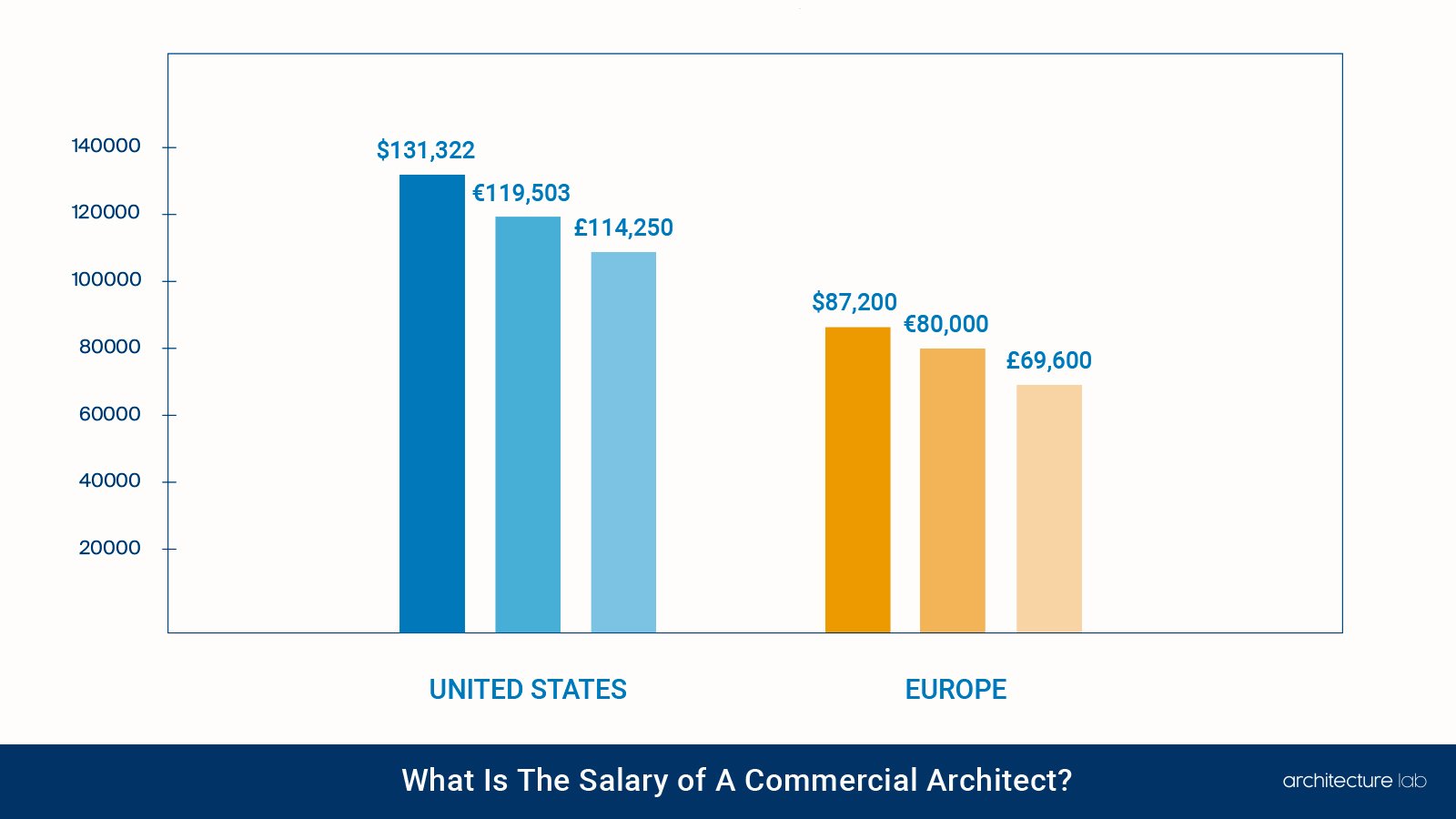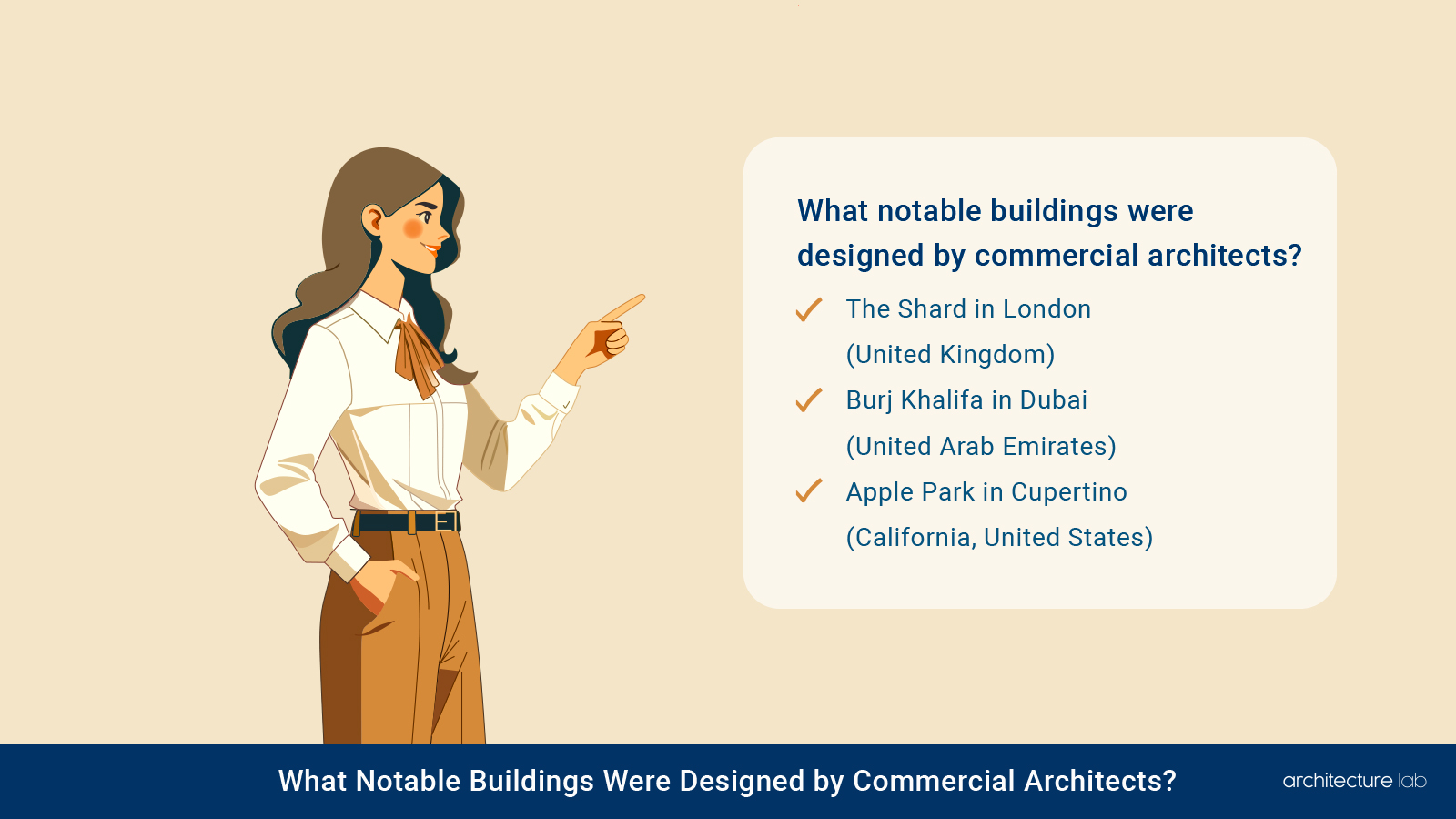Commercial architects design buildings and spaces for commercial purposes, such as offices, retail outlets, restaurants, hotels, and factories. They create architectural plans, budgets, schedules, and specifications for their clients and oversee the construction process. They also ensure their designs comply with building codes, safety standards, and environmental regulations. To become a commercial architect, one typically must complete a five-year bachelor’s or master’s degree in architecture from an accredited program, gain practical experience through an internship, and pass the Architect Registration Exam (ARE) to obtain a license. Commercial architects may also pursue continuing education courses to update their knowledge and skills. The average salary for a commercial architect in Europe is $87,200(80,000€, £69,600) per year, while in the United States, it is $131,322 (€119,503.02, £114,250.14) per year. Commercial architects also have ethical responsibilities to the public, their clients, colleagues, and their profession. They must follow the code of ethics and professional conduct established by their respective professional organizations, such as the American Institute of Architects.
What is a commercial architect?
A commercial architect is a professional who designs and oversees the construction of buildings and spaces for commercial purposes, such as offices, shops, restaurants, hotels, and factories. Commercial architects must consider the client’s needs and preferences, the business’s type and function, the customers’ behavior and expectations, and the regulations and codes that apply to the project. Commercial architect works with designers, engineers, contractors, and other specialists to create and execute a design plan that meets the project’s goals and requirements.
What are the responsibilities of a commercial architect?
The responsibilities of a commercial architect are designing and planning commercial buildings, such as office spaces, retail stores, and hotels. They collaborate with clients to understand their requirements and develop functional and efficient designs that meet their needs. The architect creates detailed drawings, blueprints, and specifications, considering safety regulations, building codes, and accessibility standards. They work closely with engineers, construction teams, and other professionals to ensure the smooth execution of the project. The commercial architect also oversees the construction process to ensure the designs are implemented correctly and within budget. Their goal is to create practical and aesthetically pleasing commercial spaces that enhance business productivity, functionality, and profitability.
What type of buildings do commercial architects commonly design?
The type of buildings that commercial architects commonly design various buildings, including office spaces, retail stores, hotels, restaurants, and industrial facilities. These architects focus on creating functional and efficient spaces that cater to the specific needs of businesses and their customers. Office spaces are designed to provide a productive environment for employees, while retail stores are crafted to attract customers and maximize sales. Hotels and restaurants require designs that prioritize guest comfort and convenience. Industrial facilities need layouts that optimize workflow and safety. Commercial architects understand the unique requirements of each type of building and work to create designs that enhance functionality, aesthetics, and profitability for businesses.
What skills and knowledge do you need to be a commercial architect?
The skills and knowledge needed to be a commercial architect are strong technical skills in building design, drafting, engineering basics, and digital 3D modeling. They need expertise in construction methods, statutory construction codes, and sustainability practices. Beyond technical abilities, a commercial architect must have strong critical thinking and problem-solving talents to realize a client’s vision within budget and regulatory limits, with additional qualifications, including knowledge of architectural history, a university master’s degree, and completion of internships. Commercial architects also benefit from strong communication, leadership, and project management expertise to work efficiently across disciplines and see large developments to successful completion.
What types of architects are the most competitive?
The most competitive types of architects are sustainable architects and modern architects. Sustainable architecture is a type of architecture that focuses on creating eco-friendly and energy-efficient buildings that minimize the environmental impact and cost of construction and operation. These types of architects must have a deep knowledge of sustainable materials, technologies, and practices, a strong aesthetic sense, and a vision for the future. They must also comply with various regulations and standards promoting green building. Green design architecture is in high demand as more people and organizations are becoming aware of the importance of environmental conservation and social responsibility, while Modern architecture is a type of architecture characterized by the use of new materials, techniques, and forms that reflect the changes and challenges of the contemporary world. Modern architects must be innovative, experimental, adaptable, and responsive to their client’s and users’ needs and preferences. Their designs must also balance functionality, beauty, tradition, and novelty. Modern architecture is highly competitive as it requires constant learning and improvement and a keen sense of the trends and movements in the architectural field.
What is the salary of a commercial architect?

The salary of a commercial architect in the United States is $131,322 (€119,503.02, £114,250.14), meanwhile, the commercial architect’s salary in Europe is $87,200(80,000€, £69,600).
Who are the most iconic commercial architects?

Listed below are the most iconic commercial architect:
- Frank Gehry: Frank Gehry is a Canadian-American commercial architect known for his innovative and expressive designs that often feature curved and distorted forms. He created iconic buildings such as the Guggenheim Museum in Bilbao, Spain, the Walt Disney Concert Hall in Los Angeles, USA, and the Fondation Louis Vuitton in Paris, France. He has won numerous awards, including the Pritzker Prize, the AIA Gold Medal, and the Royal Gold Medal.
- Norman Foster: Norman Foster is a British commercial architect who leads Foster + Partners, one of the world’s largest and most influential commercial architectural firms. He is renowned for his sleek and elegant designs incorporating high-tech engineering and sustainable features. Some of his most famous projects include the Hong Kong and Shanghai Bank in Hong Kong, China, the Reichstag dome in Berlin, Germany, and the Apple Park in Cupertino, USA. He also received the Pritzker Prize, the AIA Gold Medal, and the Royal Gold Medal.
- Zaha Hadid: Zaha Hadid was an Iraqi-British commercial architect who was the first woman to win the Pritzker Prize and the Royal Gold Medal. She was known for her bold and futuristic designs that challenged the conventional boundaries of architecture. She designed many landmark buildings, such as the Heydar Aliyev Center in Baku, Azerbaijan, the Guangzhou Opera House in Guangzhou, China, and the London Aquatics Centre in London, UK. She was also a prolific teacher, artist, and designer of furniture, jewelry, and fashion.
- Rem Koolhaas: Rem Koolhaas is a Dutch commercial architect who co-founded the Office for Metropolitan Architecture (OMA). This global firm works on diverse projects from urban planning to cultural institutions. He is also an influential theorist and writer who has published books such as Delirious New York and S, M, L, XL. His most notable buildings include the CCTV Headquarters in Beijing, China, the Seattle Central Library in Seattle, USA, and the Casa da Música in Porto, Portugal. He also won the Pritzker Prize and the RIBA Gold Medal.
- Renzo Piano: Renzo Piano is an Italian commercial architect who co-designed the Pompidou Centre in Paris, France, one of the most iconic buildings of the 20th century. He is also the founder of the Renzo Piano Building Workshop, a firm that has completed many prestigious projects, such as the Shard in London, UK, the Whitney Museum of American Art in New York, USA, and the Jean-Marie Tjibaou Cultural Centre in Nouméa, New Caledonia. He is also a laureate of the Pritzker Prize, the AIA Gold Medal, and the RIBA Gold Medal.
What ethical principles should commercial architects respect?
Listed below are the ethical principles commercial architects should respect:
- Integrity: Commercial architects should act with honesty, fairness, and professionalism in their dealings with clients, contractors, colleagues, and the public. They should uphold the dignity and reputation of the profession and avoid any conduct that might discredit or harm the interests of the architectural community. They should also respect intellectual property rights and the originality of others’ work.
- Responsibility: Commercial architects should be accountable for their work’s quality, safety, and environmental impact. They should adhere to the laws, regulations, codes, and architectural practice standards. They should also consider their design decisions’ social, cultural, and economic implications and strive to enhance the well-being of the people and the communities they serve.
- Competence: Commercial architects should maintain and improve their knowledge, skills, and architectural abilities. They should only undertake projects that are within their professional capacity and expertise. They should also seek to collaborate with other professionals and experts who can contribute to the success and innovation of their projects.
- Independence: Commercial architects should exercise their professional judgment and creativity without undue influence or pressure from any party. They should disclose any potential conflicts of interest or bias that might affect their performance or the outcome of their projects. They should also protect their clients’ and projects’ confidentiality and privacy unless required by law or by the client’s consent.
- Education: Commercial architects should promote the education and development of the next generation of architects. They should share their knowledge and experience with students, interns, and young professionals who aspire to join the profession. They should also encourage public awareness and appreciation of the value and importance of architecture in society.
What notable buildings were designed by commercial architects?

Listed below are the notable buildings designed by commercial architects:
- The Shard in London, United Kingdom: The Shard is a 95-story skyscraper, the tallest building in the European Union and the sixth-tallest in the world. The building houses offices, restaurants, hotels, apartments, and an observation deck. The building’s design was inspired by the spires of London’s churches and the masts of ships on the River Thames. The building was designed by Renzo Piano, a popular Italian architect who has also designed the Centre Pompidou in Paris and the Whitney Museum of American Art in New York.
- Burj Khalifa in Dubai, United Arab Emirates: Burj Khalifa is a 163-storey mega-tall skyscraper with the tallest building and the tallest structure in the world. The building is a mixed-use development with offices, residences, a hotel, a mosque, and a sky lobby. Islamic architecture and the shape of a desert flower influenced the building’s design. The building was designed by Skidmore, Owings & Merrill, an American architectural firm that has also designed the Willis Tower in Chicago and the One World Trade Center in New York.
- Apple Park in Cupertino, California, United States: Apple Park is a 71-hectare corporate campus that serves as the headquarters of Apple, one of the world’s most valuable companies. The campus features a circular ring-shaped building accommodating 12,000 employees, a visitor center, a fitness center, a research and development facility, and a 1,000-seat auditorium. The campus’s design was intended to reflect Apple’s innovation, simplicity, and elegance values. The campus was designed by Foster + Partners, a British architectural firm that designed the Reichstag dome in Berlin and the Hearst Tower in New York.
What new technologies are reshaping the work done by commercial architects today?
Commercial architects now commonly utilize building information modeling, 3D modeling, and virtual reality technologies. These digital tools allow architects to render comprehensive designs, structure models, thermal analyses, and other evaluations faster and more precisely during planning. Collaboration is also easier as multiple stakeholders can view interactive project schemes simultaneously, regardless of location. New technologies enhance visualization, cut waste, and streamline revisions, an important benefit for large commercial buildings with tight budgets and scheduling needs.
What software is most widely used by commercial architects today?
The software most widely used by commercial architects today is building information modeling programs, like Autodesk Revit. The modeling software facilitates data-rich 3D modeling of commercial building designs down to their nuts and bolts construction components before any physical building occurs. A key reason for its popularity is that Autodesk Revit allows all project members – architects, engineers, contractors – to coordinate work seamlessly in a shared digital model that underpins successful planning, construction, and management of sites for commercial clients.
Where can you study to be a commercial architect?
To be a commercial architect, one can study at a university. Most countries require architects to hold an accredited architecture degree, complete internships, and pass registration exams. The university program takes five years to earn a Bachelor of Architecture following a high school diploma. Students gain comprehensive design skills and knowledge in construction, structures, and mechanical systems during this time, while some obtain a professional Master’s in Architecture in less time if they enter with a related bachelor’s. After earning the proper degree and practical experience, candidates must pass registration tests unique to their homeland or state requirements.
Is a Master’s in Architecture degree enough to work as a commercial architect?
No, a Master’s degree alone is insufficient to work as a commercial architect. Most states and jurisdictions require architects to complete a professional degree program, gain experience through internships, and obtain licensure by passing registration examinations. A Master’s can fulfill the degree prerequisites in some places. However, the internship and testing steps are still necessary to be fully qualified, legalizing the ability to professionally design, sign, and seal architectural projects independently. Unlicensed practice is restricted to working under a licensed supervisor’s oversight.


